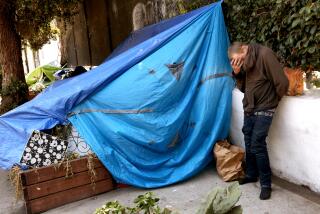Editorial: A missed chance to help L.A.’s homeless
What the homeless need most is permanent supportive housing. Not shelter beds, not handouts or the occasional hot meal. They need housing in a building or complex that offers the services they require — substance-abuse treatment, mental health counseling, job placement — to help them address the myriad issues that left them living on the streets in the first place. The goal of such housing is to enable them to live as independently as possible while supporting them in their efforts to make a successful transition into a stable life.
Officials at United Way estimate that there are currently about 14,000 units of permanent supportive housing in Los Angeles County. An additional 4,300 are being developed and should be ready for occupancy in the near future. Still, many thousands more homeless people are in need of such a home.
But creating this kind of housing is expensive and complicated, involving cooperative property owners, a government agency or nonprofit to run the operation, and a local community that won’t lobby against it. (Or, at least, will stop lobbying against it at some point in the process.)
Needless to say, favorable conditions for establishing permanent supportive housing don’t arise all that often. So when they do, it’s generally wise to seize the opportunity. That’s why it was so frustrating that a strong proposal to create 384 units in the Cecil Hotel on Main Street downtown was allowed to die.
That project, a joint public-private venture, would have mixed the supportive units with 75 affordable apartments for low-income residents and 75 market-rate units. Herb Chase, the owner of the Cecil — which attracted attention last year as the budget hotel where a young woman was found dead floating in a rooftop water tank — was on board and committed to making $10 million in renovations. The county’s Department of Health Services had agreed to pay the owner rent each year on the apartments for the homeless. The United Way’s Home for Good task force on homelessness supported the project. The ground floor would have offered space for retail and restaurants.
But as the Downtown News reported in mid-March, the project ran into fierce opposition from the Downtown Los Angeles Neighborhood Council, as well as from Tom Gilmore, the developer of residences, restaurants and shops in the Old Bank District in the city’s historic core, which includes the Cecil Hotel.
More crucially, the project was opposed by Los Angeles County Supervisor Gloria Molina, in whose district the hotel is located. All opponents voiced roughly the same not-unreasonable criticism: Permanent supportive housing should be decentralized and dispersed across the region. That area of downtown is already saturated with supportive and low-income housing, social service agencies and thousands of homeless people living and sleeping on the streets in and around skid row, which is also part of the historic core. Though the area is gentrifying at a rapid pace, sprouting market-rent lofts, wine bars and gastro pubs, opponents argued that this wasn’t an issue of “not in my backyard” — it was an issue of “enough already in my backyard.” As Molina said: Great project, wrong place.
It’s certainly true that permanent supportive housing for the homeless should not be built only in skid row. One neighborhood shouldn’t be asked to bear the entire burden of homelessness; that burden should be spread across the county. And to some degree that is happening. There is already supportive housing being built in other parts of the city and beyond, and there are efforts underway to create more.
But when it comes to supportive housing, location cannot be the only consideration. The first priority must be to get people housed. So when a proposed project offers a rare combination of an existing building that can be renovated, available financing, supportive services and enough curb appeal to blend in with the rest of the block, officials should strongly support it and encourage the community to do the same — and not lament that it isn’t somewhere else.
Besides, not building 384 units of supportive housing in the Cecil just leaves 384 people on the streets outside the Cecil.
More to Read
A cure for the common opinion
Get thought-provoking perspectives with our weekly newsletter.
You may occasionally receive promotional content from the Los Angeles Times.










